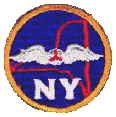
New York Wing Encampment Archive

New York Wing Encampment Archive
If you have some thoughts, memories and/or photos to add to this page, feel free to email them to the webmaster.
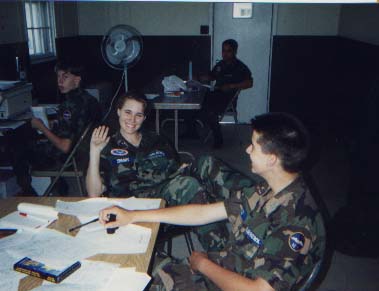 |
Cadet Smart, executive staff, relaxing |
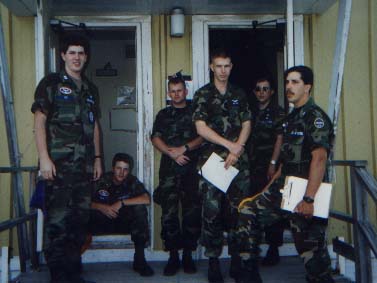 |
Left to Right: Cadets Fay and Fay (brothers), Maj Mark Crary (ANG uniform), S/M Andrew Welsh (AFROTC uniform), 1Lt Rob Rovida, 1LT Passno |
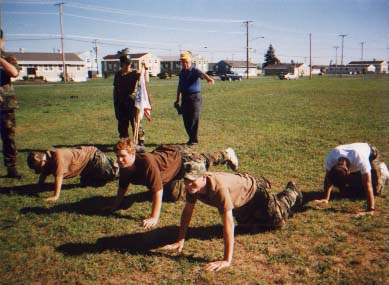 |
Cadets sweating it out in the Ultimate Frisbee penalty box |
Cadets and staff alike enjoyed live A-10 firing demonstrations for the first time. Since the encampment had the use of two "deuces" (2.5 ton trucks), a convoy of deuces and HMMV's (hum-vees) traveled the dusty road to Op-9 deep into the woods and hilly terrain that is Fort Drum's live target range. Travelers choked happily on the fine dust that was kicked up. The poor cadets who were on the back end of the truck (there was a bench on either side) were half-white from dust and half-normal.
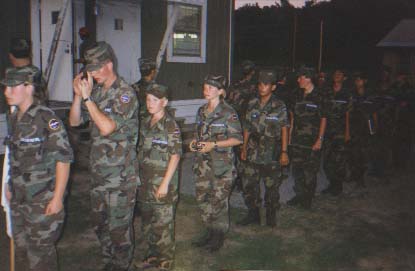 |
Echo flight from 1995 standing in single file ready to go somewhere. The cadet adjusting his hat is Brian Lenhardt, and the cadet with the camera is Emily Genser. |
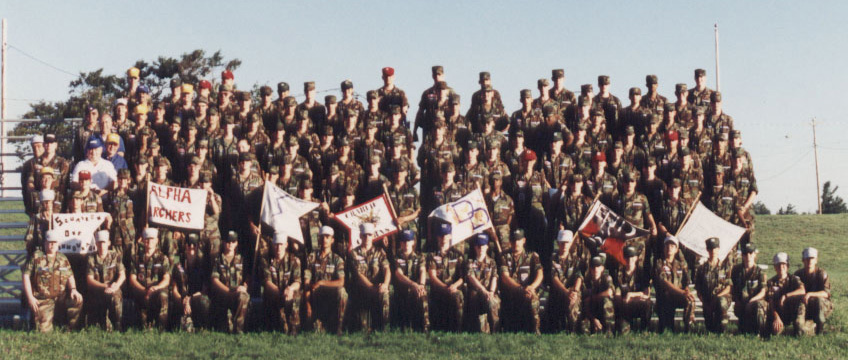
The 1994 ES Encampment at Camp Smith was commanded by Lt Col Janet Schachner.
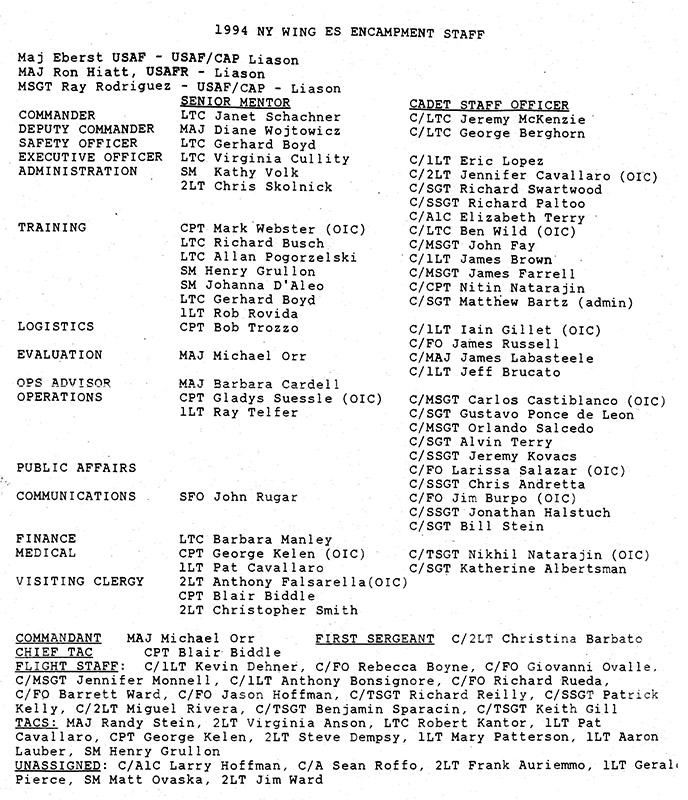
Staff Roster
Cadets awoke each morning to C/Capt Jeremy McKenzie (1st Sgt) chanting "Good Morning, Cadets", to which they replied, "Good Morning First Sergeant. We're all in our places, with bright shining faces, ready to start a new day!" After 7 days of this, the Air Assault school chanted the same thing at the start of their PT session from across the parade field, loud enough for us to hear it.
Once, the cadet color guard somehow lowered the flag halyards (hooks) reversed (as if they had gone over the top of the pole). The result, after the flag was raised, was the flag being stuck on the top of the pole! After the National Anthem was long over, the encampment patiently standing at present arms, the cadets finally gave up. The flag was stuck up there until the following afternoon when it was pulled loose and lowered.
The Camp Smith encampment's primary purpose was to provide quality Emergency Services training. Each graduate earned a "101 card" which qualified them for general ES and ground team practices. A crack team of training staff provided high-quality ES instruction. Cadets also enjoyed night navigation using a compass on one of the Army's toughest compass course. This was conducted in concert with the overnight bivouac in the outdoors.
The official encampment mission statement: "The mission of the Camp Smith New York Wing Emergency Services Encampment is to fulfill all of the requirements of an encampment; to fulfill all of the requirements of the emergency services 101T ground team member card; to develop effective cadet leaders; to instill a sense of pride, esprit de corps, and professionalism; and to develop teamwork and self disciplne in a safe and effective encampment environment, which will serve as a role model of encampment excellence for all other wings."
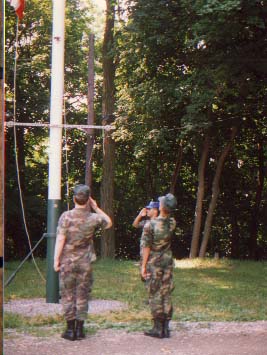 |
Color guard retrieving the colors at closing formation |
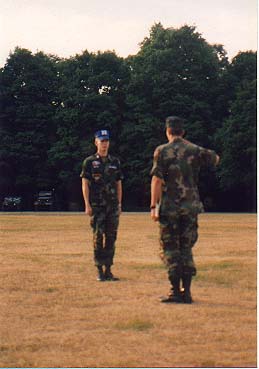 |
Formation, C/Capt (1st Sgt) Jeremy McKenzie reporting to C/Lt Col (XO) Welsh |
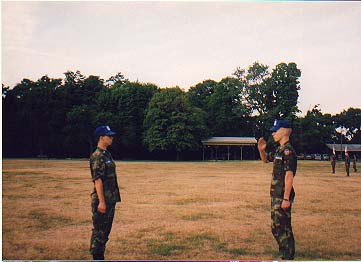 |
C/Lt Col (XO) Welsh reporting to C/Maj Eric Gilmour (DCC) at same formation as above. |
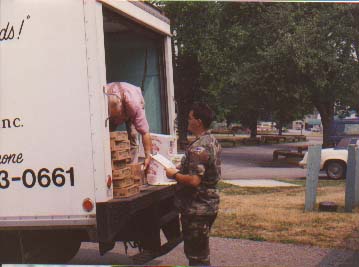 |
C/FO Kurt Paeper (Mess Ops OIC) unloads food supplies from truck behind mess hall. |
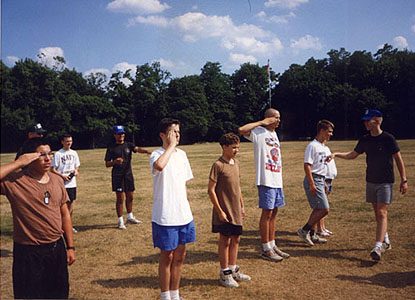 |
Cadets playing O'Grady Says (AKA "Drill Down" or "Knock out drill"). C/Lt Col Welsh is eliminating cadets, the 2nd cadet from the left (Cadet Eric Lopez) in the plain white T-shirt won. |
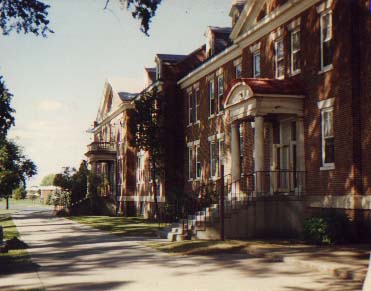
1992 was the last year that New York Wing Civil Air Patrol conducted an encampment at the ROTC barracks at Plattsburgh AFB. An attempt was made in 1993 to use the facilities, but by then the base had been closed due to the massive post-1980's downsizing of the military at the start of the Clinton Presidential administration.
This encampment was also the first time, after successful implementation at Stewart ANGB and Camp Smith, the introduction of mentoring and the complete cadet executive staff. So, for the first time on record, Plattsburgh had a cadet executive staff of more than 3.
Cadets in flight were "still" expected to learn the "54 commands of standard drill". They "still" learned it, because by that point, there was talk of eliminating the 54 commands of standard drill from the National Cadet Competition, of which by encampment in 1992, Northeast Region had won the last 4 in a row (NER won later in December, 1992 for the unprecedented 5th time in a row).
Until 1992, the encampment enjoyed the use of the chow hall in the basement of the barracks buildings, but due to the immenent closing of the base, the encampment was forced to use the general mess hall, which was a 5 min bus ride on the newer side of the base. AFROTC did not conduct a summer field training encampment at Plattsburgh in 1992-- the encampment was always conducted immediately after the field training so the AFROTC cooks could just stay on for the extra 2 weeks. Without those cooks, the training schedule was suddenly filled with travel time to chow.
Also due to the closing was the end to the USAF orientation rides cadets used to enjoy-- no more Heuey UH-1 or KC-135 rides, since those operational units had cleared out of the base by the encampment. Cadets still did get orientation flights on CAP aircraft, however.
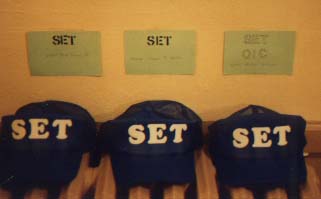 |
At the entrance to each bay of the barracks were two radiators. These radiators were perfectly suited for use as "parking spots" for staff cadet's hats-- one of those unwritten practices/traditions followed by cadet staffs since the colored staff hats were introduced in 1987/88. The Stan/Eval team (SET) wore blue hats-- the same color as the cadet command staff, since SET was performing a command function (inspections). This was the last year SET wore blue hats at a NYWG encampment. The SET team "reserved" their parking spots with the placards above the radiator in the staff office entrance. |
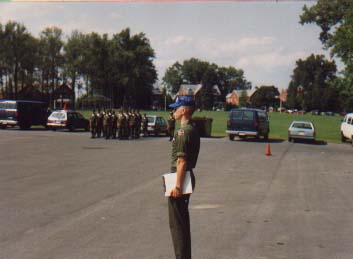 |
C/Maj Andrew Welsh (member of the Stan/Eval team) performing the daily evaluation of the "54 standard drill commands" of one of the flights in the "famous" parking lot immediately across the street from the barracks. This parking lot is where daily formation and drill practice was conducted. Pre-1991, 'marching tours' were also conducted here for cadets that earned demerits. |
The 1992 Emergency Services encampment at Camp Smith was commanded by Lt Col Janet Schachner. Cadets in flight had the opportunity to earn an ES 101T card (ground team qualified) if they completed all the activities. This was prior to the National Emergency Services Academy (NESA) being available as a national activity, and was the only centralized ES training in Northeast Region outside of Hawk Mountain at the time. A full cadet executive staff and the staff mentoring concept started in 1990 at the Camp Smith encampment. This model was later adoped at all NYWG encampments and is still currently in use.
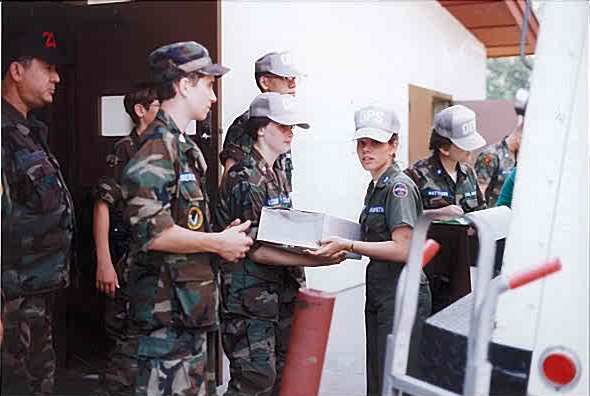
Cadet Operations staff helping load food into the dining hall. The person looking at the camera is C/LtCol Stacy Wend.
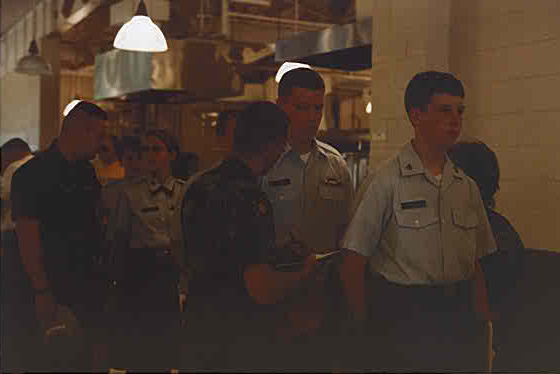
Cadets inprocessing at encampment
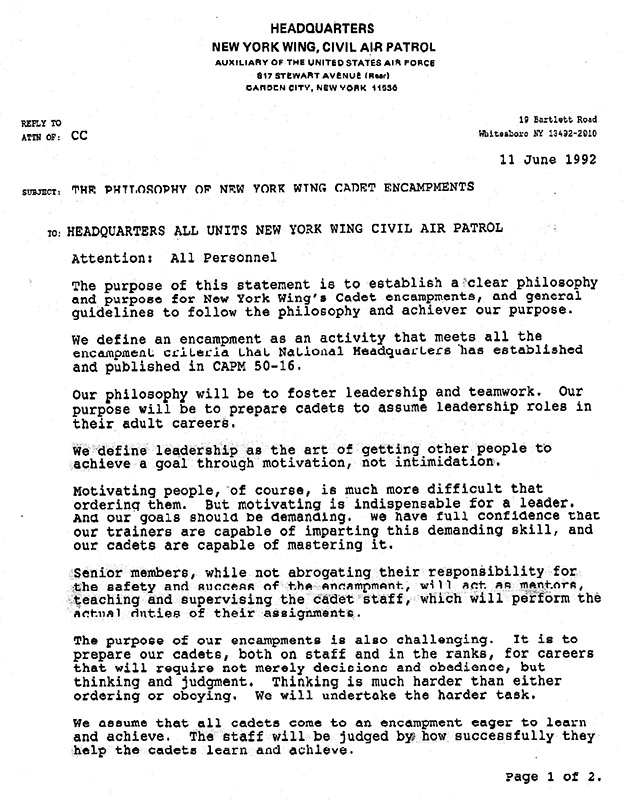
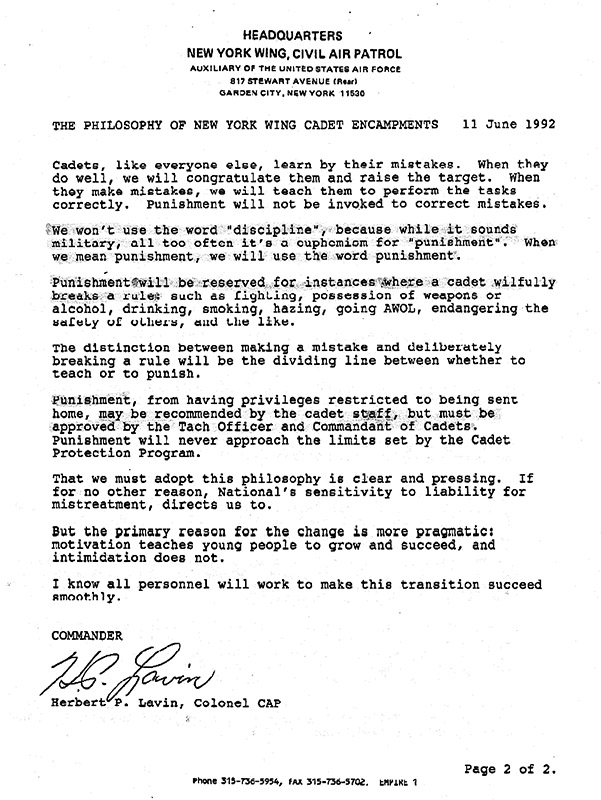
Encampment Philosophy letter from the NYWG Commander at the time, addressed to the 92 staff.

The 1991 Plattsburgh encampment was the second and final encampment commanded by Maj Robert Kantor, a former Spaatz cadet. There were several noteable happenings at this particular encampment. In 1991, CAP-USAF authorized the use of the Battle Dress Uniform, beginning the phase-out of the olive drab fatigue uniform. The encampment was mix-and-match when utility uniforms were worn.
Each year, CAP would take over the barracks the day after the AFROTC completed its annual summer field training there. Generally the building would be in good condition, because AFROTC would be back the following year. However, the AFROTC staff knew that 1991 was the last year field training would be conducted there. Plattsburgh AFB's facilities used by CAP were then the oldest ROTC barracks of any kind in the US- built in 1911. The staff arrived into a building left in shambles by AFROTC.
The cadet staff was tasked with the daunting challenge to move from the attics all of the parts to then assemble 80 of the bunks to be used at the encampment. Most of the furniture items (chairs, desks) were stowed in the hallways, outside the offices. It took 10 hours of raw physical work of 40 people to complete this task-- and most of the staff preparation/training time before the arrival of the in-flight cadets-- was unexpectedly taken up by this task.
About 5 days into the encampment, cadets from a flight in the upstairs male barracks in Squadron II (the middle section of the building, 2nd floor) had inadvertenly mixed ammonium and bleach in a mop bucket (there was residue in the bucket, and a cadet added the other chemical). The noxious fumes combined with poor ventilation caused two cadets from this flight to pass out when the hallway was mopped. Being the middle of the encampment, cadets and staff alike were on edge with one another, tired both physically and mentally, combined with this happening around 9:30 pm at the end of a long day-- stress levels were high. Some cadets went into a tizzy when the base ambulance arrived to transport the passed-out cadets. The ambulance had to come back (creating more distress) for another cadet who passed out due to the fumes. The Plattsburgh AFB fire department then pulled the fire alarm to evacuate the building to allow it to ventilate.
Everyone grabs their blankets (cadets learn to do this in fire/evacuation drills) and head out to the grass parade field across the street. While waiting for the building to clear, lightning starts flashing and it begins to pour rain. So now we have stressed out, soaked cadets in the middle of a lightning storm. The seniors herded the cadets into the staff office section of the building until the barracks were cleared by the fire department.
Later on, cadets took the opportunity to tour the FB-111 facilities-- what proved to be the last tour any CAP group took of FB-111's, since this was the only FB-111 unit in the US. The unit was halfway through moving to England at the time of the encampment. At this time, the writing was on the wall for Plattsburgh AFB, since it was slated to be closed. Cadets also got an impromptu static display tour of two US Marine AV-8 Harriers which happened to be visiting Plattsburgh AFB. 1991 was also the last year the Leaderhsip encampment enjoyed Heuey UH-1 orientation rides. Certain cadets (those who had not gone before) also got orientation rides on KC-135's at the base there. The bulk of cadets also got orientation flights in CAP aircraft.
The final noteable happening was in the middle of the pass-in-review parade at the conclusion of the encampment, all dressed up in our shiny blue uniforms, it began to pour rain, forcing everyone (parents, guests, dignitaries, staff and cadets) back into the base theatre where the graduation ceremony had started earlier.
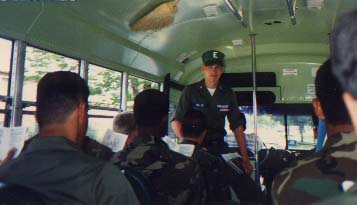 |
C/FO Andrew Welsh (E Flight Sergeant) aboard the bus on its way to some tour or activity, with the cadets in flight "reading their blue books"-- a small handbook filled with the standard operating procedures and items for memorization by cadets, called a "blue book" because of it's blue cover. Although not utilized as much in 1991 as in the past, flight staff often had cadets "read their blue books" to fill the time-- while waiting for chow or on the bus. |
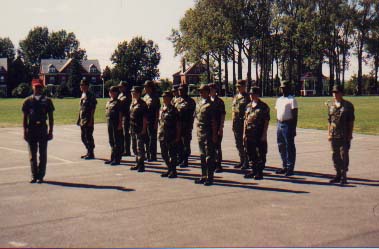 |
Echo flight practicing their drill and ceremonies on the first full day of encampment. |
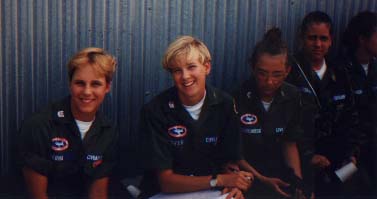 |
From Left to Right: Cadet Emily Sediva (Hotel flight CC, female flight), Cadet Tracy Figler (Hotel Flight sergeant, female flight), <don't know>, and also looking at the camera- Cadet Christina Barbato (who later became Cadet Commander at the Fort Drum encampment in 1996). This was at the flight line for the static AV-8A Harrier display. |
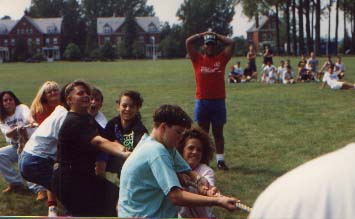 |
The female flight participating in the tug-of-war competition at the encampment picnic. The female flight (Hotel) eventually lost to Echo flight (led in part by C/FO Andrew Welsh) in the championship round. |

The 1990 Plattsburgh encampment provided many exciting aviation opportunities for cadets. Almost all cadets received rides on the KC-135 to watch mid-air refeulings of B-52s and C-130's. Cadets also got rides on the UH-1 Heuey around the city of Plattsburgh area, and orientation flights aboard the CAP aircraft. The USAF also allowed cadets to participate for 1-2 minutes each on the KC-135 simulator, attempting a takeoff. The honor cadet from each flight received 5-10 minutes of "stick time" in the FB-111 simulator. A close up, static display of the FB-111 was available to cadets.
The 1990 encampment proved to be the last NYWG encampment to have survival training conducted by AF survival instructors. Cadets proceeded to the woods having been issued only a sleeping bag. Shelters had to be constructed, and the food had to be earned with "pooosh-ups". Many "pooosh-ups" were done to get spices added to the stew of potatoes, fatty beef chunks and carrots. It surely would be a flavorless concoction without the spices (salt also being considered a spice). The "food" was aptly named "survival stew".
Other activites included a base tour, a view of the pressure chamber, a 1 mile hike up a mountainside away from the base and the town, many volleyball matches, two picnics, and a cadet dance.
The 1990 encampment was also noteable, as it was the last NYWG encampment to be the maximum length allowed by CAP- 14 days. With two weeks of training, the first weekend was consumed with a full blown cadet competition, modeled after the National Cadet Competition, with innovative drill, quiz bowl, timed mile run and volleyball included. This was also the last encampment where innovative drill was done as part of the honor flight competition-- cadets only performed innovative drill at the "Class A" inspection where the points were doubled or tripled.
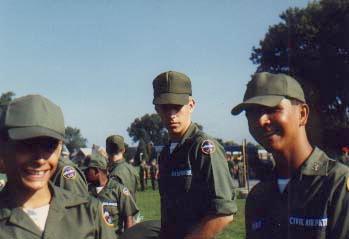 |
C/A1C Andrew Welsh (cadet in Echo flight) looking at the camera. The sour look is due to the fact that the person taking the picture took it from its owner against his wishes at the moment. The other two thought it was pretty funny. This was while standing around waiting for some activity or ride. |
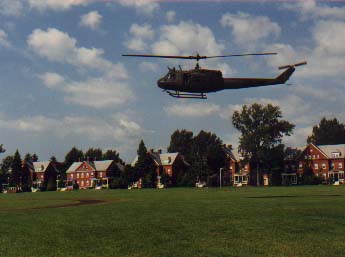 |
Heuey UH-1 landing on the parade field when arriving to give the encampment orientation rides. This was before the safety briefing. The cadets found out about the rides with the helicopters landing on the pad-- the cadet staff intentionally did not tell them about this. |
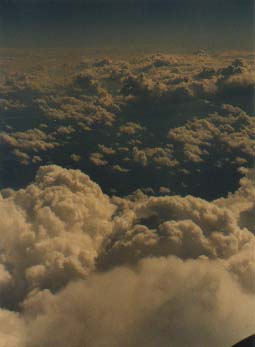 |
Picture taken out the window of the KC-135 while on an orientation flight. |
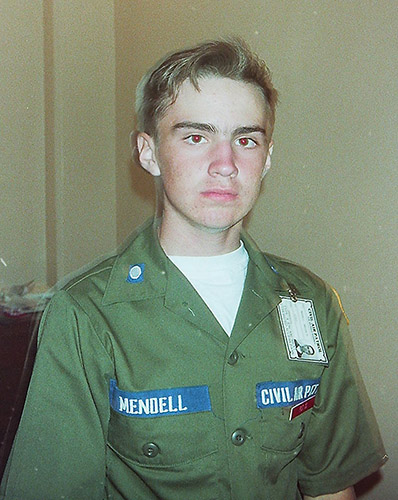 |
Cadet 2nd Lt Mendel has a position plate and barracks access pass on his fatigue uniform shirt. |
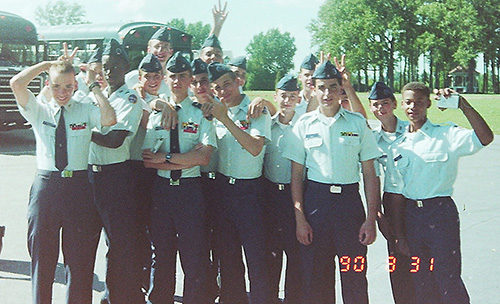 |
A group of in-flight cadets at the 1990 Plattsburgh encampment. |
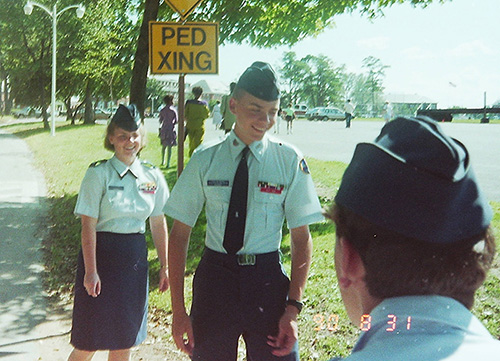 |
Some cadets joking around in the parking lot. |
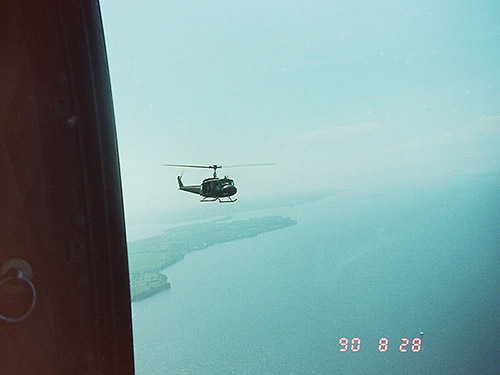 |
Lake Champlain as seen from the Hewey orientation ride. |
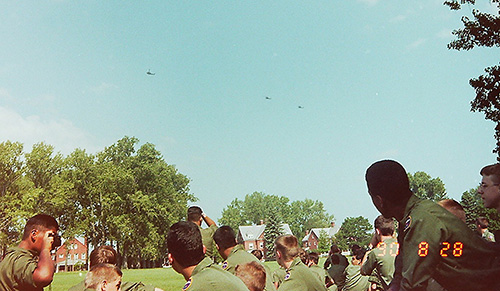 |
Cadets watch as the helicopters land in the parade field. |
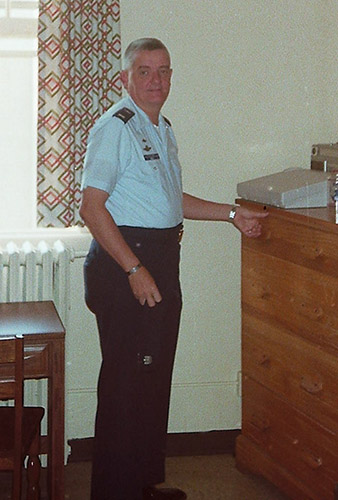 |
Retired SMSgt Blair Biddle in the barracks. |
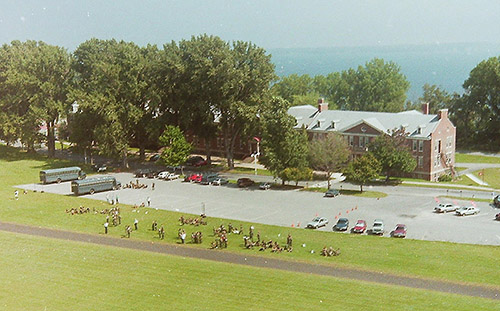 |
Plattsburgh Encampment barracks, drill / formation pad and PT field as seen from the Hewey. |
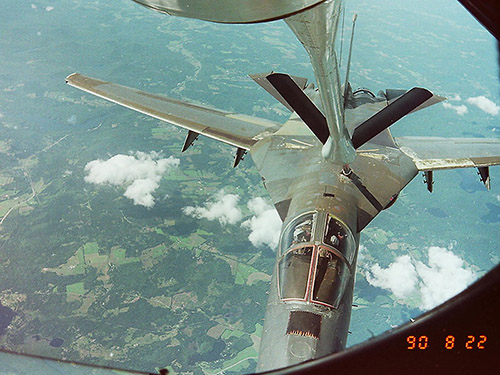 |
FB-111 being refeueled by a KC-135 tanker aircraft. Cadets enjoyed orientation rides aboard the KC-135 during this encampment. |
This encampment was commanded by Maj. Anthony Moye
Click here for a PDF of the graduation program and complete attendance roster for the 1988 encampment.
Press release from the encampment: Page 1 | 2 | 3 | 4 | 5 | 6 | 7
This encampment was commanded by Lt Col John Marek.
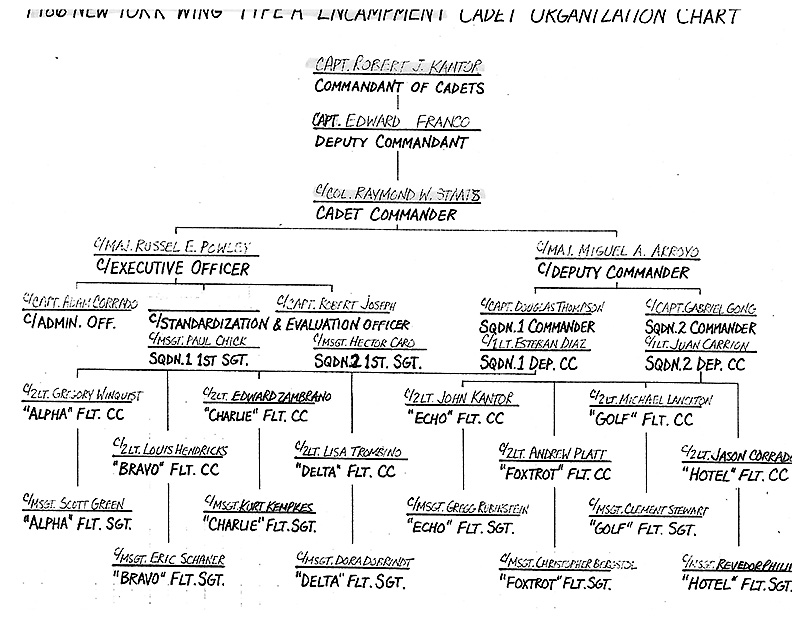
Staff org chart
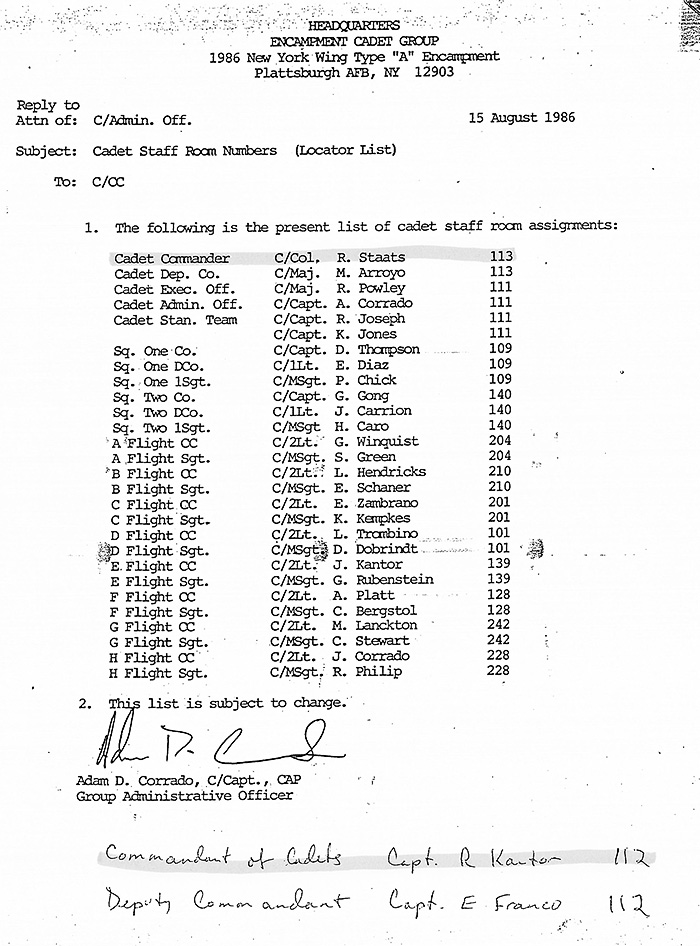
1986 Plattsburgh Encampment Staff Roster
This encampment was commanded by Lt Col John Marek.
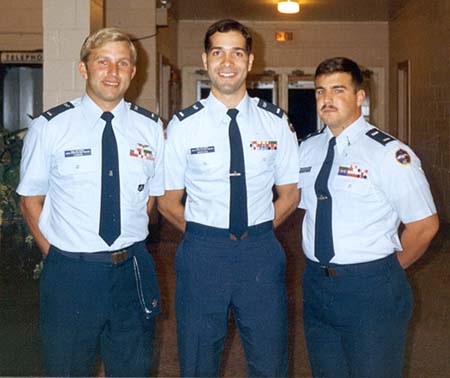
Newly-turned seniors Lennon and Marcayda, as well as 1Lt Cole

Click here for a complete list of cadet graduates.
Click here to see the dining-in invitation.
Click here to see the staff roster official memo
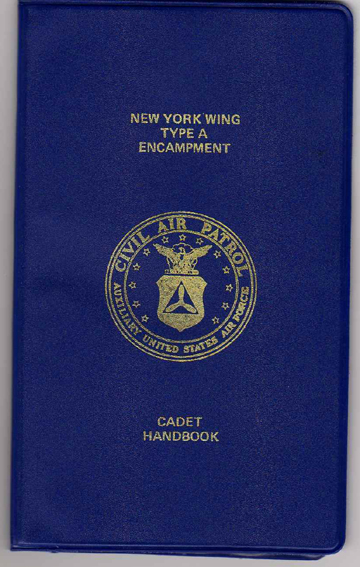
1984 Plattsburgh Encampment Blue Book cover - cadets were issued one at inprocessing
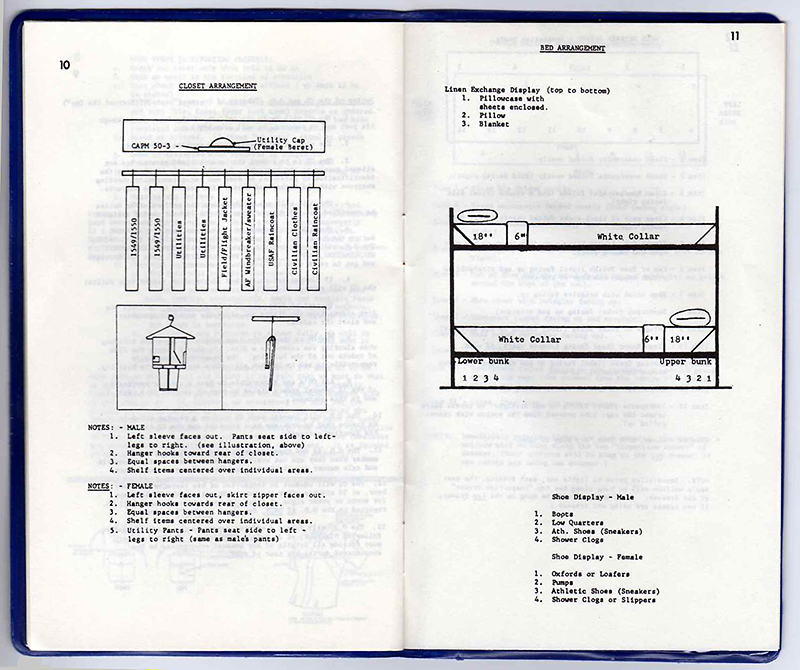
1984 Plattsburgh Encampment blue book - cadets were expected to arrange their barracks to the standards in the book, as well as memorize the contents of the book during the encampment
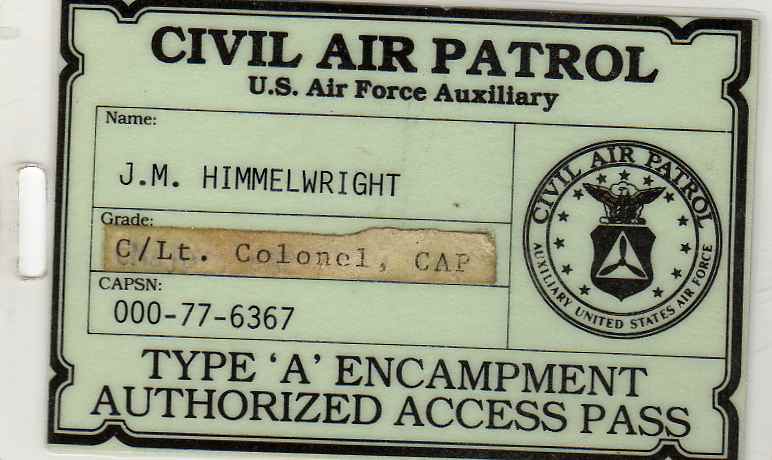
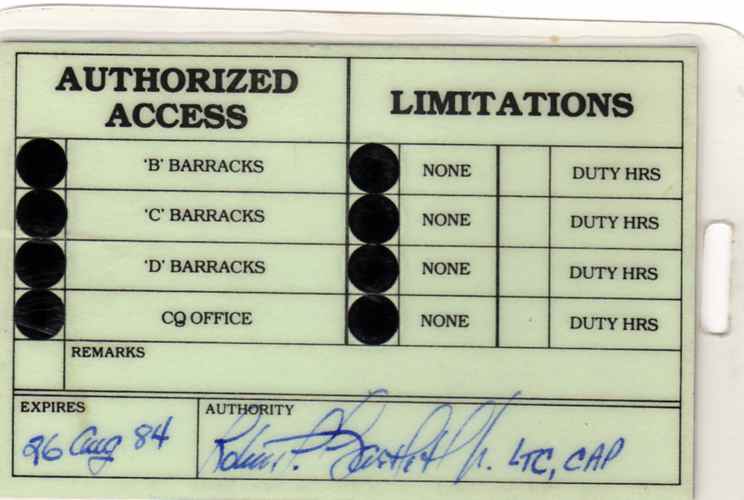
1984 Plattsburgh Encampment Staff Access Pass. Cadet staff were issued barracks access passes during the activity, and cadet CQ's were expected to challenge the staff to determine if their pass permitted them to enter the various sections of the barracks.
Senior Staff:
-Encampment Commander: LtCol John J. MarekCadet Staff:
-Commandant of Cadets: LtCol Robert P. Bartlett Jr.
-Deputy Commandant of Cadets: 2dLt Donald Prince
-Deputy Commandant of Cadets: SFO Michael D. Cole
-Director of Administrative Services: Maj Irene M. Bevers
-Assistant Director of Administrative Services: Capt Christopher Beatty
-Director Of Operations: Maj Irene M. Bevers
-Training Officer: 1stLt Robert J. Kantor
-Public Affairs Officer: Capt Jane Parot
-Assistant Public Affairs Officer: 2dLt Edward Franco
-Communications Officer: Capt Robert Vanson
-Special Services Officer: 1stLt Steven Sullivan
-SAR Instructor Pilot: Capt John Biggers
-Pilots: LtCol Louis Mahoney/ Maj Vincent Musicaro/ Maj Ralph Cocchiola/ Capt George Burns/ Capt Jacques Hinrich/ Capt Carol Maffettone
-USAF Reserve Officer: Capt Donald L. Holmes, USAFR
-Cadet Commander: C/Col Hector E. Marcayda
-Cadet Deputy Commander: C/LtCol Jon Himmelwright
-Executive Officer: C/Maj James Lennon
-Training Officer: C/Capt Xavier Manderson
-Administrative Officer: C/Capt Russel Powley
-Special Services Officer: C/FO Daniel Nikodem-Squadron I:
-Commander: C/Capt William Wemple-Squadron II:
-Senior NCO Advisor: C/SMsgt Christen Gibney
-Deputy Commander: ???
-First Sergeant: ???
-A Flight Commander: C/2dLt Susan Redding
-B Flight Commander: C/2dLt Douglas Thompson
-C Flight Commander: C/1stLt Paul Pacheco
-D Flight Commander: C/2dLt Victor Epstein-Commander: C/Capt Raymond Staats
-Deputy Commander: C/1stLt Brian Zoll
-First Sergeant: C/MSgt Richard Raimondo
-E Flight Commander: C/2dLt Gabriel Gong
-F Flight Commander: C/2dLt Neville Coma
-G Flight Commander: C/2dLt Miguel Arroyo
-H Flight Commander: C/2dLt Robert Joseph
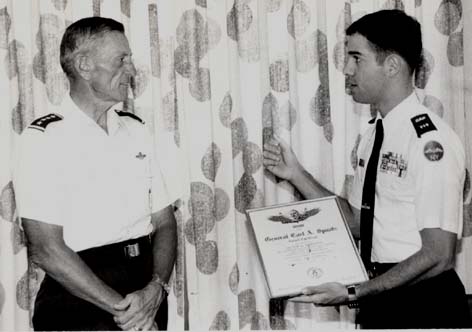
1983 Type A Encampment at Plattsburgh AFB: Concluded on 26 August 1983
Click here for a complete cadet roster
Click here for the cover of the Standard Operating Procedure, and page two.
Senior Staff:
-Encampment Commander: LtCol Josephine D. Cordone (her 26th encampment)
-Commandant of Cadets: LtCol Robert P. Bartlett Jr.
-Deputy Commandant of Cadets: 2dLt Charleen D. Betz
-Deputy Commandant of Cadets: CWO Donald Prince
-Deputy Commandant of Cadets: CWO Michael D. Cole
-Director of Administrative Services: Capt Mark R. Caiello
-Training Officer: 1stLt Thomas J. Lennon
-Assistant Training Officer: 1stLt Robert J. Kantor
-Public Affairs Officer: 2dLt Edward Franco
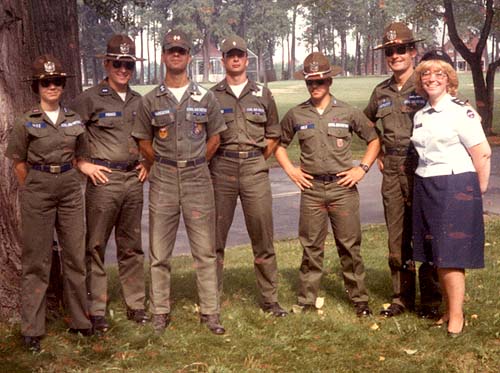
Cadet Staff:
(note that Discretionary grade was given at encampment for cadets staff.. these grades don't reflect the cadet's actual achievement)
-Cadet Commander: C/LtCol Hector E. Marcayda
-Cadet Deputy Commander: C/Maj Christopher W. Hai
-Special Services Officer: C/1stLt Karen A. Wilson
-Sergeant Major: C/CMSgt Johan Zamoscianyk-Squadron I:
-Commander: C/Capt Johanthan Himmelwright-Squadron II:
-Deputy Commander: C/1stLt William Wemple
-First Sergeant: C/MSgt Jeffrey Kuhr
-A Flight Commander: C/2dLt Anthony Jones
-B Flight Commander: C/2dLt Mark Springer
-C Flight Commander: C/2dLt Jesus Figueroa
-D Flight Commander: C/2dLt Michelle Raimondo-Commander: C/Capt James Lennon
-Deputy Commander: C/1stLt Raymond Staats
-First Sergeant: C/MSgt Scott Morley
-E Flight Commander: C/2dLt Frank Seminaro
-F Flight Commander: C/2dLt Brian Zoll
-G Flight Commander: C/2dLt Michael Rivera
-H Flight Commander: C/2dLt Richard Raimondo
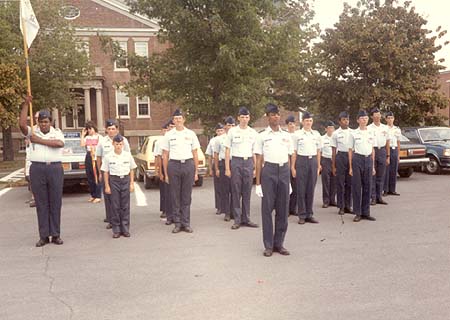
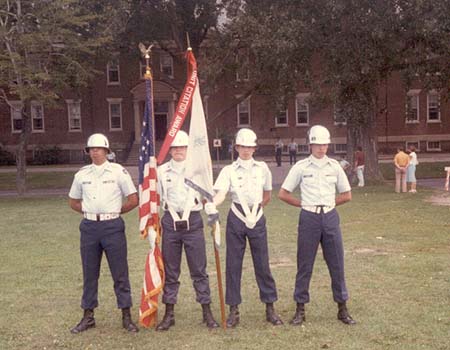
Encampment color guard preparing for pass-in-review, next to parking lot, barracks in background.

Senior Staff:
-Encampment Commander: LtCol Josephine D. Cordone (her 25th encampment)
-Commandant of Cadets: LtCol Robert P. Bartlett Jr.
-Cadet Commander: C/Col Robert J. Kantor
-Cadet Deputy Commander: C/Maj Reginald E. Allen
-Special Services Officer: C/WO David Kowalski-Squadron I:
-Commander: C/Capt Hector E. Marcayda
-Deputy Commander: C/1stLt Johanthan Himmelwright
-A Flight Commander: C/2dLt Lyndon Grey
-B Flight Commander: C/2dLt James Lennon
-C Flight Commander: C/2dLt Raymond Staats
-D Flight Commander: C/2dLt Armondo Arias-Squadron II:
Around table starting from left to right in back row: Cadet Arias (with shoulder boards), Cadet Himmelwright (holding notebook, this cadet later became cadet commander in 1985), Cadet Lennon, Cadet Grey and Cadet Staats. Squadron 1 staff enjoying a meal in Plattsburgh's barracks basement chow hall.
Note the ID card on Cadet Himmelwright's shirt. These ID cards were issued to staff identifying which barracks areas and what times they were authorized to enter. The cadet CQ on duty would examine this and allow or disallow entry based on the ID. The practice of ID card issuance was continued at PAFB encampment until 1991.Awards won by Squadron 1 at the encampment this year. Includes honor flight, honor squadron and Project X awards. The Squadron 1 "Golden" Guidon, being held by C/A Frank Chiarella. Click here to look at the guidons from squadron 1 that year. The squadron 1 flight staff posing outside their barracks area. The squadron 1 staff posing outside their barracks area. Cadets Himmelwright and Marcayda hanging out in the barracks. Cadet 2nd Lt Kowalski, Group Special Services Officer (GSSO) enjoying the fine dining at the encampment. -Commander: C/Capt Peter Sperico
-Deputy Commander: C/1stLt Michael Pawlack
-F Flight Commander: C/2dLt Robert Kirkland
-G Flight Commander: C/2dLt William Frazier
-H Flight Commander: C/2dLt Timothy Evans
-I Flight Commander: C/2dLt Karen Wilson



To look at the yearbook and senior staff roster, click on the following links:
Yearbook cover | Senior Staff | Senior Staff pg 2 | Squadron 1 | Squadron 2
Dining + Recreation | Cadets Training | Activities | Dining In | Graduation
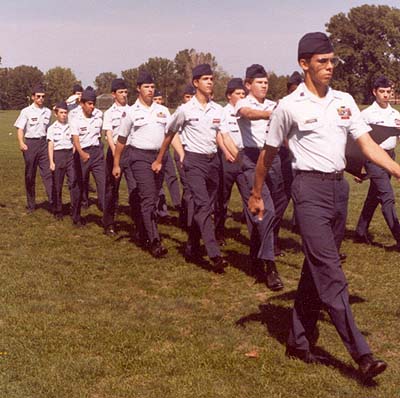 | India flight marching across parade field. The flight guidon is sticking straight out because the flight is at eyes right. Note the flight sergeant and element leaders are wearing a red tag underneath the ribbons on their left breast pocket. These were nametags identifying their staff position ("position plates"), and were issued at the Plattsburgh encampment up to and including 1991. |
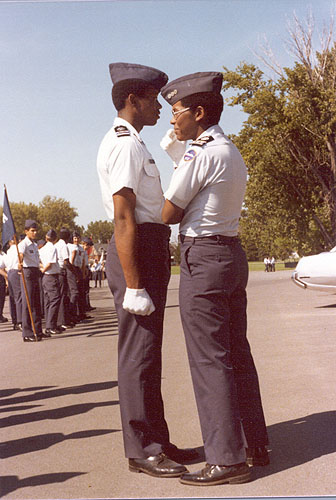 | Cadets Spencer and Worrell during the flight's Type A inspection in the drill/formation parking lot at Plattsburgh, facing the barracks. |
A Flight 25
B Flight 22
C Flight 28
D Flight 26
E Flight 19 (female flight)
F Flight 18
G Flight 26
H Flight 24
I Flight 19Total cadets: 207